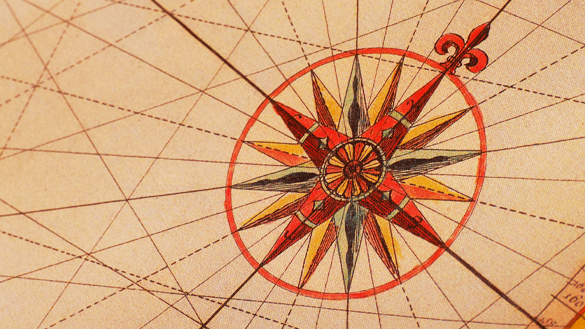Minds On
Finding our way
How do you find your way to a new place you’ve never been to before?
How does anyone find their way to a new place they’ve never been to before?
What can you do if you find yourself lost?
We can refer to our directions, a map and/or ask someone trustworthy for directions if we’re lost.
It’s also helpful to locate a landmark like a body of water, mountains, a tall noticeable building or something unique that you can use as a reference point to help orient you and your directions.
In this learning activity, we’ll be learning how to give clear directions along with making a simple map.
Action
Part 1
If we’re inviting someone to visit us, we give them directions on how to arrive at our address.
If we’ve been invited somewhere that we’ve not been before, usually our hosts will give us directions or we can ask for directions.
We might be in a new building like a school and need to find a new classroom, the gym, library or washroom, or we might have a visitor and we need to help direct them to find the school office.
Can you think of situations where you’ve seen someone use a map? Maybe you’ve used a map before. Think of some situations where you’ve seen or used a map.
Maps! Maps! Maps!
There are maps for our neighbourhoods, natural parks, amusement parks, cities, provinces, countries and for the world. You may have seen or used a map in a video game. Maps are part of GPS systems in smartphones, some cars and car keys, planes, and even some modern watches. There are jobs and careers to make and design maps and mapping technology and software.
When we give or use directions, it often helps to have a map of the area along with the directions.
Can you identify some elements on this map?

This image has visuals of the following: a map with a compass showing a house, a street, a supermarket, a police station, a school, a park, and a legend.

Compass rose
This is a compass rose. Going in clockwise direction, the compass rose shows the directions North, East, South, West.
North, East, South, West are called the cardinal directions.

The word cardinal is an adjective that tells us these four directions are of great importance.
However, the word cardinal is also the name of a beautiful red bird found in North America. The word cardinal also is a kind of red colour. There are actually 31 different uses of the word cardinal, and you’ve just learned three!
Often people remember the order of the cardinal directions with the saying Never Eat Sour Worms.
You may wish to make up your own saying to remember the order of cardinal directions:
N(Blank) E(Blank) S(Blank) W(Blank)
Take a look at the three examples of the compass rose below and see how it can be presented in slightly different ways. Always remember to read the cardinal directions of the compass rose in the clockwise direction.
Compass rose

Compass rose with circle

Simplest compass rose

Why is this called a compass rose?
The compass rose first appeared around the 1300s on maps for navigating the seas called portolan charts. The middle of the compass resembles the rose petals.
Can you see the resemblance?



Legend
Next look for the legend on our map example. The legend has symbols or icons that indicate what the symbol or icon shows.
Can you spot the symbol for park? Can you locate the park on the example map in part 1 of the Action section?
Sometimes the legend is called the key or a map key like in the following legend example.

In this learning activity we’ll use words like the cardinal directions of the compass rose:
north, south, east, west
and other directional words like
left, right
When using a map, typically we try to use the compass rose directions north, east, south and west instead of right and left. Sometimes you’ll hear people use the words above or below but try to stick with the cardinal directions.
Exercise 1
Take a look at the following map and questions. What directions would you give to get to the locations mentioned? (Hint: identifying any landmarks along the way can be helpful.)
a) Starting from the police station, give directions on how to get to the supermarket.
b) Starting from the school, give directions on how to get to the second house after stopping by at the park.
c) Starting from the first house on the left, give directions on how to get to the school after stopping to pick something up from the supermarket.
d) Starting from the last house on the right, give directions on how to get to the park after stopping by the police station.

Exercise 2

Using the map of the city provided, give the following directions:
- Starting from the train station to the post office
- Starting from the post office to the train station
Think about some questions that people may ask for getting around in this town.
Record your questions and directions. For example,
Question: How do you get from the flower shop to the supermarket?
Directions: Go south on Pine Street, go east on King Street and the supermarket is at the corner of King Street and Oak Street.
Student Wellness
Time to move it!
Good work! Now it’s time to get up, stretch and take another health and movement break with Kara, Drew, and Dalmar by exploring the following video!
Part 2
Word work
This may be a lot of new vocabulary in this learning activity. Let’s review some key vocabulary and some high frequency words to do some word work.
- direction
- directions
- legend
- compass rose
- map
- neighbourhood
- street
- cardinal
- north
- east
- south
- west
- follow
- hallway
- map key
- right
- left
- straight map
- turn
- forward
- proceed
Spelling strategy
We can say words out loud to help us sound out the words.
When we look at a word or a new word, we can look at the beginning letter and sound out the beginning letter, then look at the letter groups after. A simple example is
cat
c is the beginning letter, and at are the letters that follow.
c-at
We can also look at the beginning or in the word for letter clusters like
cr ch br tr th st ph sh str shr
Let’s look at the word
straight
Can you find a letter cluster in the word?
str are the letter clusters at the start of the word
We can look for vowel blends like
ea ee ou oo ay ey ai au
Can you see a vowel blend inside the word?
straight
The vowel blend in straight is ai.
We can also look at the word endings. In the word straight, the letters
gh are silent. What is the end sound in the word straight?
straight
It’s t.
Now we put the beginning sounds, letter blends and word ends together.
str-ai-ght
Can you find the silent letter combinations gh in the Word Work list?
| # | Col 1 | Col 2 | Col 3 |
|---|---|---|---|
| 1 | direction | south | west |
| 2 | compass rose | legend | right |
| 3 | cardinal | street | east |
| 4 | directions | hallway | map |
| 5 | neighbourhood | north | map key |
| 6 | proceed | follow | turn |
| 7 | straight map | forward | left |
Silent letters
To learn a bit more about silent letters, explore this lesson with Teacher Charmain.
Challenge word
Try the spelling strategy with the word direction.
What is the beginning sound?
Are there letter blends inside the word?
What is the end sound?
As you read more, you’ll begin to notice some more letter clusters and spelling patterns. English has words that follow rules and patterns but also words that break those rules and patterns. You’ll learn with regular reading and writing practice.
Remember, if you’re not sure, you can always try your best to spell out a word, and then check your spelling using a:
- word wall
- online dictionary
- personal dictionary
- picture dictionary
- high frequency word list
Consolidation
Providing directions
Consider for a moment a building that you have spent some time being inside such as a school, a place of worship, or a shopping mall. Let's write directions for getting around in that building.
Safety alert: who should you give directions to?
In real life, before you give directions to someone, make sure you check and have permission from a trusted adult or teacher and always remember NOT to give away any personal information to strangers, like:
- your school name
- your address
- names of family members and friends
- the addresses of extended family members and friends
Part 1
Student Success
Using checklists
Record 5 different sets of directions.
After you’ve written your directions, check for spelling, capitals, and punctuation.
Directions Checklist
Correct use of directional words:
Map has legend with:
Punctuation Checklist
Capital used:
Periods used:
Commas used:
Rewrite your directions with the appropriate spelling and punctuation corrections.
Note to teachers: See your teacher guide for collaboration tools, ideas and suggestions.
Part 2
Make a map of your neighbourhood. Write directions or record directions for a friend to get from your home to the bus stop on a lined sheet of paper.
Use the checklists to help you.
Reflection
How do you feel about what you have learned in this activity? Which of the next four sentences best matches how you are feeling about your learning? Press the button that is beside this sentence.
I feel...
Now, record your ideas about your feelings using a voice recorder, speech-to-text, or writing tool.
Press ‘Discover More’ to extend your skills.
Discover MoreYears ago, without the use of maps, how did people orient themselves?
What landmarks did they use?
Examine this video of The World Around Me for a clue of one technique used.



